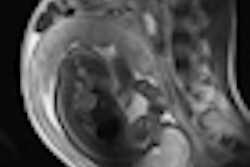Lose a breast or abort a fetus? These are the choices offered to most women diagnosed with early-stage breast cancer in the first or second trimester of pregnancy.
Breast-conservation surgery becomes an option for pregnant women in their third trimester. For many of these women, radiation therapy can safely be postponed until after birth. But the option of breast-conserving surgery may become available to all pregnant women if electron-beam intraoperative radiation therapy (IORT) is used.
That's according to a new study designed to determine the in vivo dose delivered to nonpregnant, premenopausal patients undergoing electron-beam IORT at the time of breast-conservation surgery. The results of the study, from the European Institute of Oncology in Milan, Italy, suggest that the radiation dose generated by the procedure is safe for pregnant women during their first and second trimesters. Findings were published online in the Annals of Surgical Oncology (October 21, 2008).
Electron-beam IORT enables breast radiotherapy to be completed in a single session following quadrantectomy, wide-excision, or nipple-sparing mastectomy. At the European Institute of Oncology, a full dose of 21 Gy prescribed at 90% isodose is delivered in a single fraction by a mobile linear accelerator. Aluminum and lead disks 5-8 mm in size with a thickness of 6-8 mm are placed between the residual breast and chest wall as internal shielding to protect the underlying tissues during the treatment.
Between January and April 2008, 15 women volunteered to have in vivo dosimetry performed during breast-conservation surgery, followed by electron-beam IORT. This was used as the only irradiation treatment or as a boost prior to conventional radiation therapy to the whole breast.
Thermoluminescent radiation detectors in the form of microrods placed in a thin plastic envelope were positioned subdiaphragmatically on the side of the body being irradiated, approximately 10-15 cm from the application, and at the medial suprapubic position 30-40 cm from the application. They were also inserted in the uterus using a catheter. Shielding aprons were placed on the abdomen to block electron scatter.
The detectors were analyzed 24 to 48 hours after being exposed to radiation, with the readout converted to an absorbed dose. The results are summarized below:
|
The findings that the intrauterine dose was about half that of most cranial doses, and about twice that of most caudal doses, suggest that surface dose measured at the subdiaphragmatic level may be considered the upper limit of the dose absorbed by the fetus, according to the researchers, led by Dr. Viviana Galimberti, director of the institute's unit of molecular senology. She and her colleagues noted that a fetal dose of up to several mGy is considered acceptable by the International Commission on Radiological Protection (ICRP).
By comparison, the radiation therapy dose for conventional breast cancer is 50 Gy in 25 daily fractions for the whole breast. This dose is equivalent to an estimated 20-240 mGy to a fetus up to 24 weeks gestation, increasing to 2,000 mGy in late pregnancy.
Based on their findings, the researchers suggest that electron-beam IORT can be used in conjunction with breast-conservation therapy for a patient in the first trimester of pregnancy. A full dose of 21 Gy can be considered because the fetus is located in the lower part of the pelvic region.
For patients in their second trimester, the researchers suggest that an intraoperative boost dose of 12 Gy could be administered if the time between surgery and conventional whole-breast radiotherapy after parturition does not exceed 16 weeks. The researchers cautioned that use of the treatment would be "less prudent" for a patient whose fetus is at 30 weeks gestation because of the close location of the fetus to the breast.
"Electron-beam IORT offers the pregnant woman the choice of receiving breast-conserving surgery without exposing her baby to a significant radiation risk," Galimberti and colleagues wrote. The results indicate that electron-beam IORT with a mobile linear accelerator and shielding apron would be safe for the fetus, according to the researchers.
The European Institute of Oncology will offer this treatment to its patients, Galimberti told AuntMinnie.com in an e-mail. In the six months since the study was completed, none of the institute's early-stage breast cancer patients has been pregnant, which is not unexpected as pregnant women represent only one out of 1,000 patients with breast cancer.
By Cynthia Keen
AuntMinnie.com staff writer
November 17, 2008
Related Reading
SNL procedure in pregnant breast cancer patients leads to negligible fetal dose, August 14, 2006
Intra-operative radiotherapy good alternative after breast-conservation surgery, September 19, 2002
Copyright © 2008 AuntMinnie.com



















